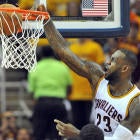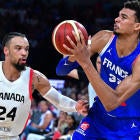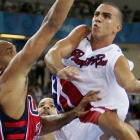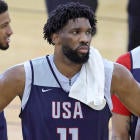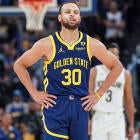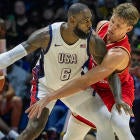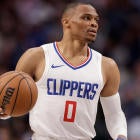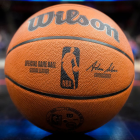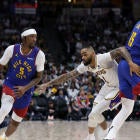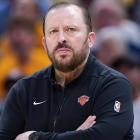Get out and run!
There aren't a lot of fan bases that revel in a slow-paced team. We want running and gunning. We want fast break dunks in flurries that leave the opposing team's collective head spinning until it unscrews from the collective body. But not everybody is equipped to run off misses, run off makes, and speed up the game. Some personnel are built to be slow, plodding, and bore the life out of their opponent. Other personnel are there to run as much as possible and find their way into the paint before their opponent can sprint back on defense.
The tricky part with determining which team is good at being fast-paced and which team is bad at being fast-pace is not paying attention to pace much at all. Thanks to advanced statistics, we can properly judge offense, defense, and transition on a level playing field. The Phoenix Suns gave up a lot of points during the Mike D'Antoni years, but as we soon became more educated about possessions and pace, we learned that his teams were more likely middle of the road defensive teams than just bad defensive teams because they had more possessions than anybody else.
Not all of those possession counts are created equal though. The 2010-11 Minnesota Timberwolves had the top pace in the NBA and David Kahn was making up some term called "up-tempo DNA" to distract you from their win total of 17. But dig deeper into their pace and you'll discover they were tied for 24th in percentage of transition opportunities, 28th in transition scoring efficiency, and 29th in turning the ball over. Their pace was because they were sloppy with the basketball, one of the worst defensive teams in the NBA, and played recklessly instead of a calculated way.
When measuring how good a team is in transition, you need to factor in pace but more importantly you percentage of transition possessions and their scoring efficiency in those possessions are much more meaningful.
Looking at how teams last year and projecting how they might do next season, I've identified five teams I think need to run less often and five teams that should try to run more.
Five Teams That Should Run Less
 Phoenix Suns
Phoenix Suns
23rd in Transition PPP, 10th in Transition Percentage, 30th in Turnover Rate
The Suns were the fourth "fastest" team in the NBA in terms of pace, but really it's just because they were the worst team at taking care of the basketball. With such a tumultuous season between assistant coaches being fired, Jeff Hornacek getting canned, and injuries to the starting backcourt, it was hard to expect the Suns to be relatively competent as the season progressed. This team tried to run a lot, tallying up the 10th highest percentage of transition possessions in the NBA. But that turned out to be a really bad thing because they were 23rd in scoring efficiency in transition.
So even though they were running quite a bit, it didn't do them any good because they were both in a horrible area of frantic, chaotic pace they couldn't control and they sucked at scoring in transition. With Brandon Knight and Eric Bledsoe both missing significant time, the Suns decided to throw lottery pick Devin Booker into the fire not only as a scoring option but also a playmaker. It had its good moments and its bad moments, but he looked mostly out of control leading the break in transition opportunities.
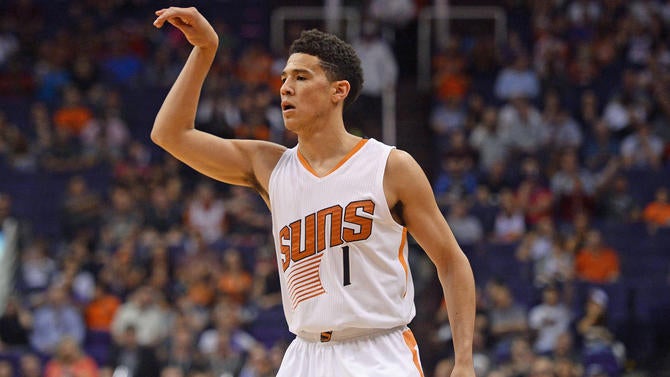
As a ball handler, Booker was terribly inefficient, which is fine for a rookie. He couldn't generate even one full point per possession (0.977) -- mostly because he turned the ball over 26.4 percent of the time. If he tried to throw a lob or get a pass ahead into the middle of the floor, it was often sailing out of bounds into the abyss of the baseline photographers. But throw Booker on the wing to fill the lanes and he lit opponents up. Combining left wing and right wing opportunities for him, he scored a ridiculously efficient 1.33 points per possession and turned the ball over less than 4 percent of the time.
The Suns just need to slow down in general, even if Bledsoe and Knight are healthy this season. Having them handling the ball and letting Booker fill the wings will make them more efficient, but the cost-effectiveness of them trying to push the pace is detrimental to being a good team.
 Sacramento Kings
Sacramento Kings
20th in Transition PPP, 3rd in Transition Percentage, 24th in Turnover Rate
The Sacramento Kings were ... interesting last season. While DeMarcus Cousins' incredible individual season was often lost in the disarray of this team throughout the organization (mostly surrounding George Karl), this team tried to run everybody out of the building and did a horrible job of accomplishing that. The one area in which Cousins struggled quite a bit was trying to score in transition. That was a problem considering he was nearly 14 percent of their transition opportunities alone.
When Cousins got out in transition as the big running ahead, he was a wrecking ball scoring 1.345 points per possession. When he was trailing the play, he scored an impressive 1.228 PPP. But anywhere else and Cousins really struggled to get anything going. He was a disaster leading the break as a ball handler (nearly a quarter of his transition possessions which yielded 0.672 PPP), but he wasn't the main problem for the Kings. The main problem was Rajon Rondo, who was far too sloppy with the ball and never acted as a scoring threat on these possessions.
Rondo finished in the third percentile in PPP in transition. That means 97 percent of the league created points more efficiently than he did on the break. That's astounding for such a brilliant passer, even if he's not a scoring threat. Overall in transition, Rondo turned the ball over 38.2 percent of the time. As a main ball handler initiating the break, that turnover rate rose to 40.8 percent.
Most of this stemmed from uncharacteristic indecision from Rondo in these situations. Or he just didn't see the defender helping on other occasions. Whatever the problem was in that particular moment, Rondo struggled with his new teammates last season.
This year, Dave Joerger will be taking over and Rondo is off to Chicago. Darren Collison (we still don't know what his season will be after a guilty plea for domestic battery) and Rudy Gay were the Kings' best transition players last season and with Cousins in better shape and playing for a coach he'll likely respect, I think he'll be a more efficient weapon in transition too. Mostly the Kings should be more efficient while running far less under Joerger and being better with the ball.
Let's throw out last season for Joerger because of the injury madness in Memphis. In the first two seasons with Joerger as the Grizzlies coach, the team finished sixth and 10th in transition PPP, 28th and 26th in transition percentage, and 10th both years in turnover rate, respectively. Transition should be far more measured for this roster, and you can expect it to be this season.
 Washington Wizards
Washington Wizards
18th in Transition PPP, 2nd in Transition Percentage, 15th in Turnover Rate
The Randy Wittman small ball era with the Washington Wizards was amazing in the same way that Steven Seagal movies after he started exclusively wearing kimonos are amazing. None of it was good but you couldn't look away if you tried. After having small ball success in the postseason, they decided to make it a big time part of their approach last season and it wasn't good. The Wizards were below average in scoring efficiency while being the second-highest percentage of transition possessions in the league. They were middle of the road in taking care of the ball, which wasn't a disaster but it didn't help their push for quality pace either.
Guys like Bradley Beal (when he was able to play) and Otto Porter were good in transition, but the rest of the team was pretty much average at best. John Wall had the third most transition possessions in the NBA but wasn't able to overwhelm with his speed and athleticism in transition as much as you'd expect. He was good passing the ball in transition and kept the turnover rate just under 20 percent, but he didn't hack it as a scorer and barely cleared a full point per possession (1.019).
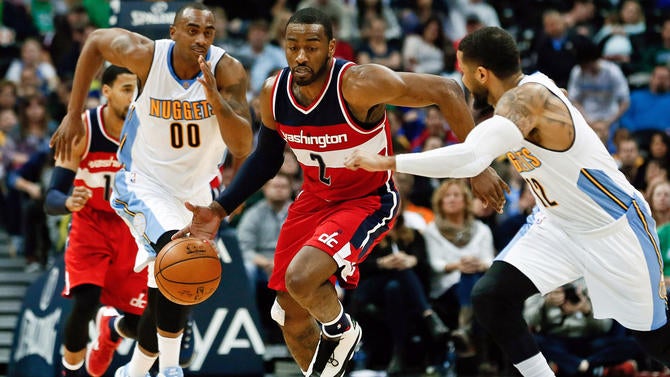
The Wizards under Scott Brooks will probably run less often than the Wizards did this past season, but the Sonics/Thunder were always top 10 in the league in percentage of possessions that were in transition under Brooks. They were also one of the best in the league in transition almost every season but they had Russell Westbrook and Kevin Durant to work with most nights. For the Wizards, the goal should be to have a similar efficiency (8th in the NBA) as the Thunder did during the 2014-15 season when Kevin Durant missed more than half the season.
Using Wall as Westbrook in this comparison is easier said than done, but if the big men (Marcin Gortat, Ian Mahinmi, Markieff Morris) can run effectively and Beal can stay healthy, Wall should have plenty of weapons to open up space for him. At least last season they learned that just deciding to run doesn't do much. You have to know how to run, as well.
 Oklahoma City Thunder
Oklahoma City Thunder
12th in Transition PPP, 6th in Transition Percentage, 28th in Turnover Rate
Speaking of the Thunder, they were good at transition scoring last season, and did it a lot. They had big problems with turnovers, but it didn't stop them from being a deadly team in transition. When you have Durant and Westbrook taking up over 50 percent of your transition possessions, you can be an entirely overwhelming on the break to your opponents. Here's the problem heading into this season: they don't have Durant anymore.
So do you double down on the style of play you had last season and hope Victor Oladipo can be a force in transition next to Russ or do you change things up and try to slow it all down to maximize efficiency? That's the tough call for Year 2 of Billy Donovan. They have good bigs in transition (Steven Adams and Enes Kanter) but those guys don't do a ton of running on the break. They have guys like Anthony Morrow and Alex Abrines who should be able to stretch to the wings in transition, but you're not sure how much you want to play them.
Oladipo was good as a ball handler in transition and hardly ever turned it over (8.4 percent of the time), but he wasn't all that good at filling the wings. He'll have a much more dangerous guard playing alongside him with Westbrook instead of Elfrid Payton, so that could open things up for him, but the Thunder can't just hope Westbrook creates everything. As dominating as he can be, the defense will only focus on him and that could create some turnover and offensive foul situations for Westbrook.
The solution is probably to pull back the reins of this team a bit and see if they can be opportunistic in transition rather than just go-go-go.
 Philadelphia 76ers
Philadelphia 76ers
26th in Transition PPP, 8th in Transition Percentage, 29th in Turnover Rate
This one starts with a caveat: This team will likely be a whole lot better than they were a year ago and they have much more skilled passers with the additions of Ben Simmons and Sergio Rodriguez. With Simmons and Rodriguez, they can have two of the better options in the NBA in passing ahead and getting quick, easy scores for the athletes on the team. If the Sixers can revert back to their defensive ways of two years ago, those stops could turn into quick scoring chances.
That would be a very good thing and you definitely want to see how Simmons can pick apart scrambling defenses with his special passing ability. However, this team will probably still struggle to score quite a bit just in general. They don't have a lot of shooting. They don't have a lot of guys who can create their own shots in tight places. Those are often essential to scoring in transition.
Selective transition is the way to go for the Sixers and not just running for the sake of running. Getting as many reps in for these young players makes sense, but you still need the majority of those to be quality reps. That's not going to happen if they're still one of the worst teams at taking care of the ball or scoring in transition. How much did they learn by running a lot but scoring rarely?
Five Teams That Should Run More
 Toronto Raptors
Toronto Raptors
1st in Transition PPP, 24th in Transition Percentage, 6th in Turnover Rate
Maybe the Toronto Raptors were the best transition team in basketball because they were selective in the way they pushed the pace, but 24th in percentage of possessions in transition is far too low for them. Their top five players in number of transition possessions all finished above 1.2 points per possession (league average was 1.104) and four of those players will return this season (Luis Scola went to Brooklyn). With as good as Kyle Lowry and Cory Joseph are at pushing the ball, you'd think Dwane Casey would feel more comfortable pushing the pace.
The Raptors do seem to want to play more small ball with DeMarre Carroll finally getting healthy, and maybe that could lead to a ramped up pace. And with young athletes like Norman Powell and Terrence Ross in the mix, you have the horses to run. However, Casey's teams have rarely been big on pushing the pace. In his five years with the Raptors, the team has finished no higher than 17th in transition percentage. Their second-highest finish was last year at 24th.
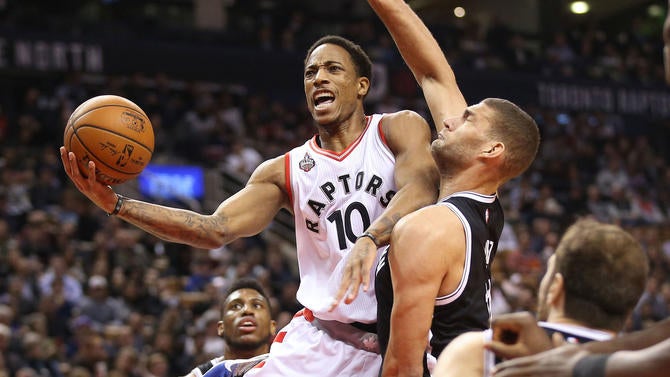
DeRozan is fantastic at leading the break as a ball handler and Lowry measures out as one of the top players at filling the wings on the break. It's a quirky swap of traditional roles in which the shooting guard is directing and the point guard is used as a complementary weapon. That alone could throw quite a few teams off in how they defend transition against the Raptors. Not to mention, the Raptors have a great dual-point guard lineup with Lowry and Joseph. But Casey just doesn't seem to want to push it.
 Cleveland Cavaliers
Cleveland Cavaliers
2nd in Transition PPP, 15th in Transition Percentage, 13th in Turnover Rate
The world champion Cleveland Cavaliers were the second deadliest team in transition a year ago, but they were middle of the road in how often they ran. Some of this makes sense because Kyrie Irving missed so much time in the beginning of the season and the Cavs are always going to pace themselves in terms of how they approach the grind of the regular season. That can lead to less and less running, but when Tyronn Lue took over and wanted to push the pace more, it was a great idea because of how effective this team was.
Maybe a full year under Lue will allow them to become a top 10 team in terms of transition frequency. They have the weapons with LeBron James being a locomotive and Kyrie Irving being a marvel with how he finishes around defenders. Throw in Kevin Love's insane outlet passes and you've really got yourself a stew going with their transition game.
 Dallas Mavericks
Dallas Mavericks
4th in Transition PPP, 30th in Transition Percentage, 2nd in Turnover Rate
Nobody embraced the transition opportunity less than the Dallas Mavericks last season. Despite being second in turnover rate and fourth in transition PPP, the Mavs just refused to push the ball. And they were often playing multiple point guard lineups with a combination of Devin Harris, JJ Barea, Deron Williams, and Raymond Felton, so it's not like they didn't have the ball handlers on the floor to push the pace and get quickly into the teeth of the defense.
Williams struggled in transition, but everybody else did a pretty good job. Chandler Parsons was their main transition weapon, and while he's moved on to Memphis, they do have someone like Harrison Barnes now, who is used to playing uptempo basketball to put the defense on their heels. You don't want Barnes out in the middle of the break or leading the break, but he's a very good weapon filling the wings (1.324 PPP). They've also added a very good shooter in Seth Curry to help fill those wings and run to the corners.
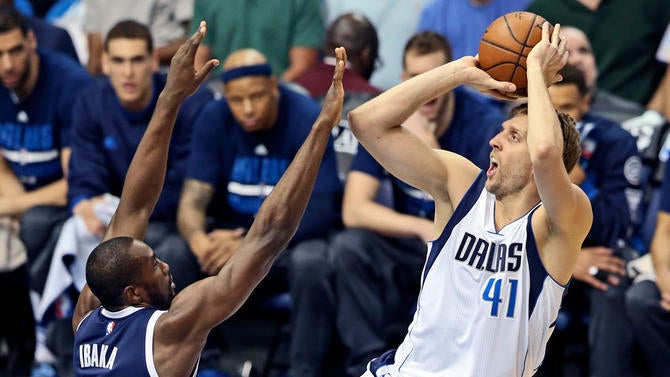
Not to mention, they have the ultimately trailer option in Dirk Nowitzki, who scored a ridiculous 1.464 points per possession as a trailer on the break. Push the ball to get the defense scrambling toward the paint and then let Dirk come down the middle of the floor and pop from the top of the 3-point arc. This should happen way more often than it does.
I'm not asking Rick Carlisle to become a top 10 team in transition frequency. They have depth issues and you don't want to burn Dirk out. Let's just get toward the top 20 this coming season and see if the water is the right temperature before we dive in more. Dip your toe in transition instead of just hanging out in a lounge chair.
 Charlotte Hornets
Charlotte Hornets
5th in Transition PPP, 28th in Transition Percentage, 1st in Turnover Rate
Despite turning the ball over 22.8 percent of the time as a ball handler in transition, Kemba Walker is a devastating force on the break. He's lightning quick. He's strong despite being of small stature. He ends up drawing fouls and finishing around the rim as he's leading a break. He's the main reason the Charlotte Hornets are so brilliant in transition, but Steve Clifford's teams just flat-out don't push the ball.
Considering how little they turn the ball over (they've been the best at it every season of Clifford's tenure), the running game is a tricky balance for them. You could be sloppier with the ball the more you push it, and ball control is as important to Clifford as help defense. It's why the Hornets are so crafty and careful with how they attack opposing teams. But they have solid young big men, athletic and rangy wings, and a point guard who excels at driving the ball down the throats of a defense on its heels.
With their newfound emphasis on 3-point shooting over the last year, they should be even deadlier moving forward with transition opportunities. They just have to want to run.
 Los Angeles Clippers
Los Angeles Clippers
6th in Transition PPP, 18th in Transition Percentage, 3rd in Turnover Rate
I know this isn't going to happen. Even with Blake Griffin and DeAndre Jordan on the team, there is a limit to how much a Doc Rivers team is going to run. There's especially a limit to how much a team led by Chris Paul will run. He doesn't just walk the dog with inbound passes in the backcourt to conserve shot clock; he's conserving his own energy too in a perfectly infuriating measurement of energy efficiency. I get all that.
However, the Clippers are so good in transition. They're so fun in transition too. Griffin and Jordan are basically two of those Game of Thrones dragons unleashing hell from up above. CP3 can direct those guys and deliver pinpoint passes that dazzle the eyes and fluster the opponents before the monster dunks come. JJ Redick filling the wings to spread the floor makes it an impossible decision to make for a scrambling defense. Not to mention, it's been a while since we saw the Jamal Crawford shake-and-bake, and I badly want to see it at least one more time in a live game.
You hear Billy Crystal there at the end, Doc! He says, "That's Clipper basketball." Let's make the running game Clipper basketball. I understand why you don't and it's probably correct, but unleash these weapons, please.









